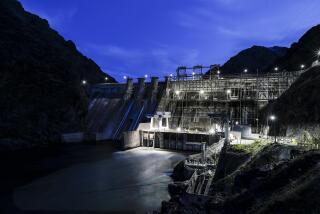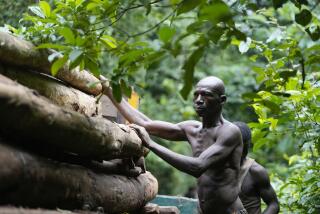Brazil Dam Produces Hardwood Along With Its Hydroelectricity
TUCURUI LAKE, Brazil — When Benedito Signey cuts a tree in the Amazon, it falls up.
He’s logging a forest at the bottom of this man-made lake in far northern Brazil.
Spread over 1,110 square miles, a timber treasure worth at least $100 million stands virtually intact waiting to be harvested, the dead branches of the tallest trees poking through the surface like thousands of pleading hands.
Underwater logging was unknown in Brazil until the construction of the huge Tucurui dam two decades ago. Today, nature and human resourcefulness have created new opportunities in what was once rain forest.
Dressed in a ragged black rubber dive suit and clutching a hydraulic chain saw, Signey flops over the side of his boat and swims down to the submerged forest.
A hundred feet below the surface is a trove of the finest Amazon hardwoods: Brazil-nut wood, mahogany, ipe, angelim, jatoba and, more notable, massaranduba, which is so hard that even iron nails bend when hammered in.
After 15 years underwater, the trees are perfectly preserved, the wood fibers protected from decomposition by the slimy organic matter that envelops them.
“The trees are dead, but they have been preserved like a body in formaldehyde,” said Wollmer Silva de Oliveira, a local official who supervises logging.
A tree is selected and tied with ropes. Signey cuts it, and the trunk is allowed to slowly rise to the surface. Before the loggers learned to tie the trunks down, logs would shoot to the surface like missiles, and some loggers were killed.
Cutting as many as 10 trees a day since 1996, underwater lumberjacks like Signey have harvested barely 1% of the estimated 1.5 million submerged trees. At that pace, it will take 150 years to harvest the rest.
“There is enough here for my whole life. Perhaps even for my children,” he said.
There wasn’t supposed to be a forest under Tucurui Lake. When the dam was built, a contract to log the area was awarded to a company run by the son of President Joao Figueiredo, the last of five right-wing generals who governed Brazil from 1964 to 1985.
The company was unprepared for the enormous task, though, and the work was further slowed by corruption--wood from Tucurui was traced to Amazon shipyards, where it was used to build yachts for high-ranking officers. When the dam’s floodgates closed in 1984, most of the forest still stood.
Ecologists had warned that the reservoir would alter the environment and outweigh the dam’s benefits. Villages were made uninhabitable by mosquitoes. Rotting organic matter produced greenhouse gases. Whole species of fish decreased in number or disappeared altogether.
“The ecosystem was devastated,” said Philip Fearnside, a scientist at the Amazon National Research Institute in Manaus. “The greenhouse emissions are very substantial and reduce the benefits of the dam more than authorities want to recognize.”
For the government, it was an acceptable price to develop the eastern Amazon. The 4,325-megawatt Tucurui hydroelectric plant not only boosted the area’s export-oriented aluminum industry but provided energy to nearly every village in the sparsely populated region. The government estimates Tucurui has saved Brazil $30 billion in oil imports alone.
And the region slowly adapted to the dam. The lake proved to be an ideal habitat for the tucunare (too-koo-nah-REH), a kind of red snapper whose juicy meat and fighting disposition make it a favorite food and game fish.
Feeding on smaller fish, tucunare became king of the lake. Thousands of fishermen flocked from around the region, and fishing became a major business. From a forgotten riverside town of 3,000 people, Tucurui grew into an economic hub of 60,000.
“It was a biological revolution that took place,” said Takashi Hatanaka, a biologist with the dam’s environmental program. “The different bed soil boosted life among small fish, which in turn lured tucunare. A life cycle began.”
Signey moved to Tucurui four years ago when the tucunare boom was taking off, but he soon saw he could earn more money logging.
Today he supports his wife and two children on monthly pay of 591 reals, or about $330--a good salary in a region where few people earn even the minimum wage of 151 reals ($84).
But the future is uncertain for the logging divers.
Big companies are taking an interest in the submerged timber, since cutting logs right on the water can save at least 25% in transportation costs. And they wouldn’t have to deal with the scrutiny of environmental groups because they would be exploiting an already dead forest.
Sulpam Madeiras Ltda., one of four timber companies operating on the lake, last year began a joint venture with Aquatic Cellulose International Corp. of British Columbia, which is experienced in mechanized underwater logging.
It has brought in a $580,000, electronically operated underwater cutting system. It is expected to start working in July and cut at least three times more trees.
The machine has “arms,” equipped with sonar sensors, that embrace a tree, cut it with a chain saw and drag it to the surface. It worked well off the Canadian coast recovering logs already cut, but that area was far smaller than Tucurui.
“Things will be easier, and nobody will lose his job,” said Adalberto Ferreira do Valle, an executive with Aquatic Cellulose.
Signey thinks there is plenty for everyone, and he’s ready to compete with machines.
“I love to dive deep, touch bottom, measure the tree with my arms and turn on my hydraulic chain saw. In three to five minutes, zazz--there goes the tree to the surface,” he says. “I want to see a machine do all that!”
*
Aquatic Cellulose underwater logging site: https://www.aquaticcellulose.com/ html/company/projects/project_updates.html
More to Read
Sign up for Essential California
The most important California stories and recommendations in your inbox every morning.
You may occasionally receive promotional content from the Los Angeles Times.










